
Edgar Allan Poe was an American writer, poet, author, editor, and literary critic who is best known for his poetry and short stories, particularly his tales of mystery and the macabre. He is widely regarded as a central figure of Romanticism and Gothic fiction in the United States, and of American literature. Poe was one of the country's earliest practitioners of the short story, and is considered the inventor of the detective fiction genre, as well as a significant contributor to the emerging genre of science fiction. He is the first well-known American writer to earn a living through writing alone, resulting in a financially difficult life and career.

Westminster Hall and Burying Ground is a graveyard and former church located at 519 West Fayette Street in Baltimore, Maryland, United States. It is currently part of the grounds of the University of Maryland's School of Law. It occupies the southeast corner of West Fayette and North Greene Street on the west side of downtown Baltimore. It sits across from the Baltimore VA hospital and is the burial site of Edgar Allan Poe (1809–1849). The complex was declared a national historic district in 1974.

Poe Toaster is the media sobriquet used to refer to an unidentified person who, for several decades, paid an annual tribute to the American author Edgar Allan Poe by visiting the cenotaph marking his original grave in Baltimore, Maryland, in the early hours of January 19, Poe's birthday. The shadowy figure, dressed in black with a wide-brimmed hat and white scarf, would pour himself a glass of cognac and raise a toast to Poe's memory, then vanish into the night, leaving three roses in a distinctive arrangement and the unfinished bottle of liquor. Onlookers gathered annually in hopes of glimpsing the elusive Toaster, who did not seek publicity and was rarely seen or photographed.
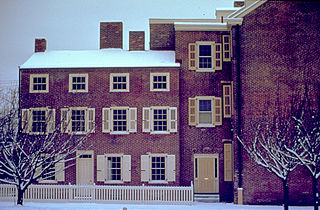
The Edgar Allan Poe National Historic Site is a preserved home once rented by American author Edgar Allan Poe, located at 532 N. 7th Street, in the Spring Garden neighborhood of Philadelphia, Pennsylvania. Though Poe lived in many houses over several years in Philadelphia, it is the only one which still survives. It was designated a National Historic Landmark in 1962.

The Poe Museum or the Edgar Allan Poe Museum, is a museum located in the Shockoe Bottom neighborhood of Richmond, Virginia, United States, dedicated to American writer Edgar Allan Poe. Though Poe never lived in the building, it serves to commemorate his time living in Richmond. The museum holds one of the world's largest collections of original manuscripts, letters, first editions, memorabilia and personal belongings. The museum also provides an overview of early 19th century Richmond, where Poe lived and worked. The museum features the life and career of Poe by documenting his accomplishments with pictures, relics, and verse, and focusing on his many years in Richmond.
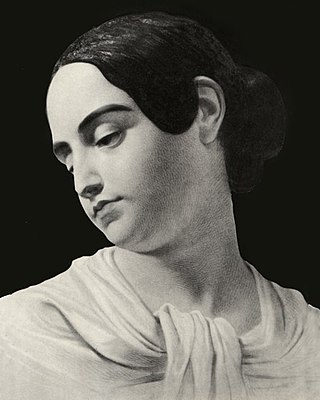
Virginia Eliza Poe was the wife of American writer Edgar Allan Poe. The couple were first cousins and publicly married when Virginia Clemm was 13 and Poe was 27. Biographers disagree as to the nature of the couple's relationship. Though their marriage was loving, some biographers suggest they viewed one another more like a brother and sister. In January 1842, she contracted tuberculosis, growing worse for five years until she died of the disease at the age of 24 in the family's cottage, at that time outside New York City.
Edgar Allan Poe Museum or Edgar Allan Poe House may refer to:

The death of Edgar Allan Poe on October 7, 1849, has remained mysterious in regard to both the cause of death and the circumstances leading to it. American author Edgar Allan Poe was found delirious and disheveled at a tavern in Baltimore, Maryland, on October 3. He sought the help of magazine editor Joseph E. Snodgrass and was taken to the Washington College Hospital, where he was treated for apparent intoxication. Poe had no visitors in the hospital and gave no account of how he came to be in his condition before dying on October 7 at age 40.
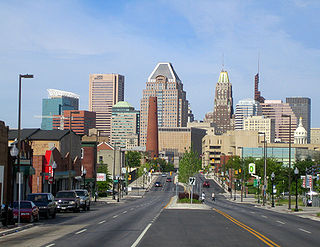
Downtown Baltimore is the central business district of the city of Baltimore traditionally bounded by Martin Luther King, Jr. Boulevard to the west, Franklin Street to the north, President Street to the east and the Inner Harbor area to the south.

The Hanover Tavern is a community center, theatre, and recreational tavern located in Hanover, Virginia. Originally built in 1733, it is one of the oldest taverns in the United States.

The Edgar Allan Poe Cottage is the former home of American writer Edgar Allan Poe. It is located on Kingsbridge Road and the Grand Concourse in the Fordham neighborhood of the Bronx, New York, a short distance from its original location, and is now in the northern part of Poe Park.
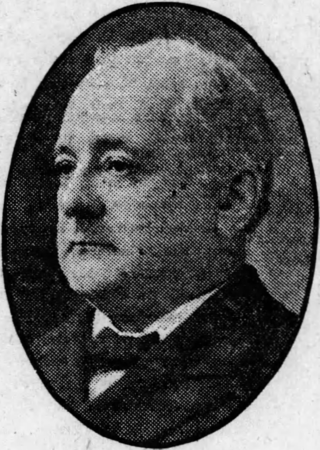
John Prentiss Poe was Attorney General of the State of Maryland from 1891 to 1895. He also served in the Maryland Senate from 1890 to 1891.
William Henry Leonard Poe, often referred to as Henry Poe, was an American sailor, amateur poet and the older brother of Edgar Allan Poe and Rosalie Poe.
Nevermore: The Imaginary Life and Mysterious Death of Edgar Allan Poe is a musical that was written, composed, and directed by Jonathan Christenson and designed by Bretta Gerecke. It follows the life of Edgar Allan Poe and the internal and external struggles he faced which are depicted as inspiring his writings. In the play, Poe struggles with tragedies such as death, abandonment, addiction, poverty, and loss. The script contains many references to Poe's poems and short stories. The script fictionalizes true events that took place in his life while also incorporating his creative works and poems. It was originally produced at the Catalyst Theater in Edmonton, Alberta, for an 11-week production that then went on to be performed at theater festivals, theaters across Canada, to the Barbican Theater in London, and the New Victory Theater in New York City.
Judge Neilson Poe was an American judge for the City of Baltimore's orphan's court,. He was initially appointed to the court by Maryland Governor John Lee Carroll in 1878 and elected to the position in November 1879. He had the job until 1883.

Poppleton is a neighborhood in west Baltimore, Maryland. The neighborhood is bounded on the north by West Mulberry Street, on the south by West Baltimore Street, on the west by North Carey Street, and on the east by the Martin Luther King Jr. Boulevard. Previously, Poppleton was construed in a broader sense extending further south to West Pratt Street or Lombard Street, but today this area is commonly described as the separate neighborhood of Hollins Market.

The Loves of Edgar Allan Poe is a 1942 American drama film directed by Harry Lachman, starring Linda Darnell and Shepperd Strudwick. The film is a cinematic biography of Edgar Allan Poe that examines his romantic relationships with Sarah Elmira Royster and Virginia Clemm. The film presents a sympathetic and positive outline of Poe's life and career.

The arts and culture of Maryland are varied; they are not just limited to metropolitan areas, but can also be experienced throughout the state. There is an eclectic mix of southern and northern American cultures influenced by its foundation as a Catholic colony.
The Odd Fellows Hall in Baltimore, Maryland, United States was a building that was the meeting place of the Independent Order of Odd Fellows fraternal organization, as well as the organization's national headquarters, from 1831 until 1890. It was the first Odd Fellows' Hall in the United States.
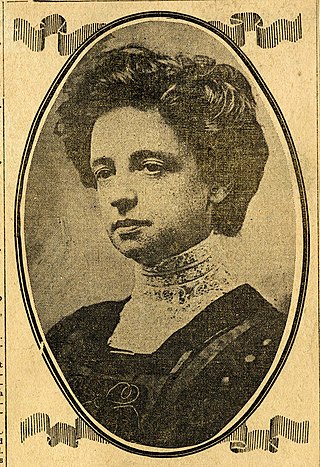
May Garrettson Evans was the first female reporter for the Baltimore Sun. She founded and directed the preparatory school of the Peabody Conservatory for over 30 years. An Edgar Allan Poe scholar, she made several important discoveries regarding Poe in Baltimore.


















